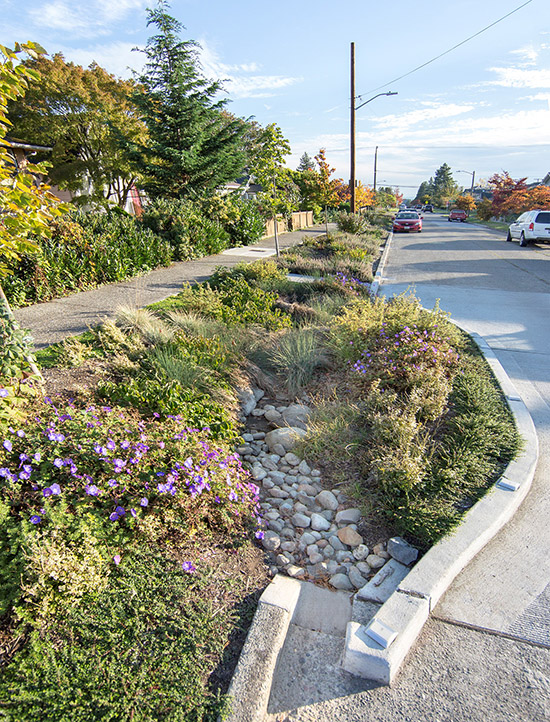|
Subscribe / Renew |
|
|
Contact Us |
|
| ► Subscribe to our Free Weekly Newsletter | |
| home | Welcome, sign in or click here to subscribe. | login |
Construction
| |
 |
January 22, 2018
Best in State: Gold Award
Future Value to Engineering Profession
MIG/SvR

Project: Barton CSO control with green infrastructure
Client: King County Wastewater Treatment Division
In an effort to control repeated combined sewer overflows near a popular Seattle park, King County's Wastewater Treatment Division decided to try a new approach.
The Barton combined sewer system was experiencing an average of four overflows a year, which discharged a total of approximately 4 million gallons of polluted runoff into Puget Sound near Lincoln Park.
The Wastewater Treatment Division typically constructed an underground storage tank on a single parcel to control CSOs, but decided in this case to use the green stormwater infrastructure solution. They chose MIG|SvR as the consultant.
The result is dozens of roadside bioretention systems — or highly engineered “rain gardens” — that pair with underground infrastructure to further infiltrate the water, reducing or eliminating overflows.
This was the first project where the Wastewater Treatment Division utilized green stormwater infrastructure to control combined sewer overflows — specifically, 91 bioretention cells connected to an underwater drain that conveyed flows to an underground injection control screen well for deep infiltration.
This approach was taken when the site assessment process determined that soils near the surface were not suitable for shallow infiltration. However, a large layer of receptive soils were found further below the hard-packed glacial till.
The team developed a new approach to the typical urban roadside bioretention system by using the screen wells to infiltrate the treated water. The team worked closely with the county's operations and maintenance staff to ensure the screen wells would be accessible for monitoring and any needed repairs.
The project also involved one of the more complex street improvement permitting projects the department had undertaken in a Seattle neighborhood.
The project started in 2011, after a 2008 county report showed significant combined sewer overflows in the Barton combined sewer system basin. The project team focused on one sub-basin that contributed 45 percent of the stormwater flows in the basin.
Within this 72-block area, the team assessed each city block for the possibility of a rain garden. Ultimately, 19 residential blocks were selected for design and permit approval, and 15 were constructed between 2013 and 2015.
The project received a platinum rating using King County's sustainable infrastructure scorecard, which looked at site sustainability, water efficiency, energy and atmosphere, materials and resource, outdoor and environmental quality, and innovation.
The project is a passive system that requires minimal operating costs, and native and drought tolerant plants reduce irrigation requirements. Coordinated design with the county's operations and maintenance staff ensured that maintenance can be performed without specialized equipment.
It is estimated the Barton project will divert approximately 6 million gallons of stormwater from entering the combined sewer system per year, reducing treatment plant and water conveyance costs.
Other Stories:
- National finalist: Platinum Award
Structural Systems
Magnusson Klemencic Associates - National finalist: Gold award
Structural Systems
COWI North America - National finalist: Gold award
Special Projects
Hart Crowser - National finalist: Gold award
Special Projects
Parsons - Best in State: Gold Award
Successful Fulfillment of Client/Owner Needs
GeoEngineers - Best in State: Gold Award
Unique or Innovative Applications
Golder Associates - Best in State: Gold Award
Social, Economic and Sustainable Design
J-U-B Engineers - Best in State: Gold Award
Complexity
Stantec - Engineer of the Year


